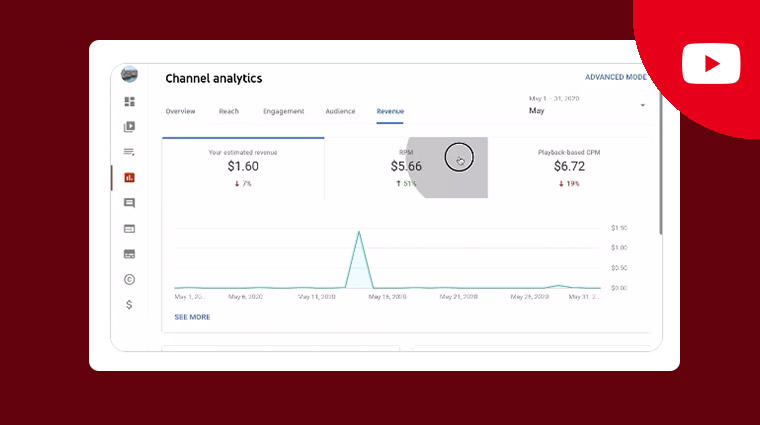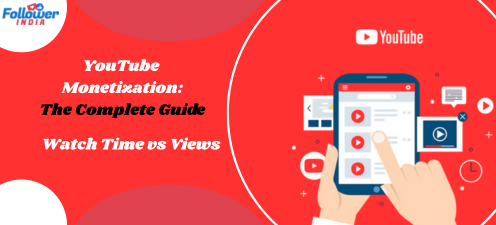On YouTube, reaching a YouTube watch time of around 1 million views is a milestone, but it doesn’t guarantee monetization. Even the channels with high viewership will be denied monetization if the content has reused or repurposed. Many creators rapidly assume viral success automatically qualifies them for ad revenue, but without meeting YouTube’s rules, monetization will remain out of reach. The YouTube Partner Program (YPP) is a policy in which creators need to meet two key aspects to monetize content: 4000 valid public watch hours in the last 12 months (or 10 million valid public Shorts views in the last 90 days) with at least 1000 subscribers. Keep in mind that any public watch hours from Shorts views won’t count towards the 4000 public watch hours threshold.
YouTube watch time is a strong indicator that ensures channels consistently engage viewers, demonstrating their ability to retain an audience. Once your channel meets the requirements that are stated above, you can apply for the YouTube Partner Program (YPP). Also, open the door for your channel to access ad revenue, memberships, and other monetization tools. After all, YouTube watch hours for monetization is a key factor that ensures new channels complete the given 4000 public watch hours and 10M Shorts views separately.
What Does YouTube Prioritize? Watch Time vs. Views.
-
Watch Time: YouTube Watch time is a critical metric that measures the total minutes viewers spend watching your videos on YouTube; it is shown as a key indicator of audience engagement. YouTube prioritizes this metric because it directly reflects videos that retain audiences and keep users engaged on YouTube longer. You have to focus on improving YouTube watch time that can enhance your channel’s visibility and attract more new viewers. According to YouTube Creator Academy, videos that maintain a 50% or higher retention rate are more likely to rank better. As these videos signal to the YouTube algorithm that the content is valuable and engaging.
-
Views: YouTube views are measured as a raw count of users watching a video for at least 30 seconds, which indicates initial interest, and they don’t guarantee long-term success. A high view count on videos may help to get your video to go viral, attracting quick attention and engaging short-term traffic. However, if those views come with low audience retention, YouTube’s algorithm will likely deprioritize the video over time. Unlike total watch time, which measures sustained engagement, views alone don’t indicate whether YouTube viewers actually enjoyed the content. For sustainable growth, it’s essential to maintain a balance between the strong metrics of view count and watch time. While view count may provide initial momentum, it’s retention and engagement that determine long-term rankings.
-
Comparison in a table: Watch Time and Views
| Metric | Definition | Impact on Monetization | Algorithm Weighting | Long-Term Ranking Effect |
| Watch
Time |
The total minutes viewers spend watching your videos. | Critical (4,000+ hours and 10M Shorts views needed for YPP) | High (Retention boosts rankings) | Strong (Sustains and enhance your visibility) |
| Views | A raw count of users watching a video for at least 30 seconds. | Indirect (Requires watch time for ads) | Medium (Helps to get your video go Viral) | Weak (Fades without retention) |
Watch Time vs. Views: Which One Earns More Money?
When it comes to YouTube revenue, YouTube watch time has a bigger impact than views because it determines how many ads are shown. The YouTube algorithm favors those videos that keep viewers engaged longer on YouTube, which allows videos to run for more mid-roll ads. CPM (Cost Per Mille) refers to the money an advertiser pays for each 1000 times their ad is displayed, but RPM (Revenue Per Mille) is what creators earn after YouTube’s 45% cut and also measures what every 1000 ad impressions generate. Longer watch time improves RPM because it can run multiple mid-roll ads that can open more earning opportunities. Let’s say a 10-minute video with 50k views can retain viewers; it may generate 3-5 ad breaks, while a 2-minute video with 200k views can only show one pre-roll ad. That’s why longer videos can run multiple mid-roll ads that help in increasing CPM and RPM.
CPM (Cost Per Mille) is focused on the advertiser’s cost, while RPM is focused on the publisher’s earnings. A 10-minute video with 50k views with strong retention will earn more than a 2-minute video with 200k because the 10-minute video can run multiple mid-roll ads while the 2-minute video only has a pre-roll ad. On 10-minute videos, engagement is better and makes RPM higher, so even fewer views can generate more revenue. The YouTube Analytics display CPM and RPM data under the “Revenue” tab within the analytics dashboard. Here is how you find them: You have to go to the YouTube Analytics dashboard to access your YouTube Studio and search for the analytics section. Then at the top of the screen there is a tab, so click on that “Revenue” tab, and you’ll see CPM, RPM, total revenue, and other metrics also displayed there.

How to Fix Low Watch Time (Even with High Views)
There are some well-proven strategies from which you can fix low YouTube watch time even if your videos have gained high views.
-
Hook viewers in the first 15 seconds: To improve the watch time of your YouTube channel, the first 15 seconds are very crucial for your video. If you fail to grab attention immediately in your videos, it will cause damage to your video retention and audience engagement. Start with a strong opening that sparks curiosity, and you can also start with a compelling question, a surprising fact, or a teaser of what’s coming to keep them wanting more. Make a goal to create an immediate impact that encourages viewers to stay on videos and watch further. This keeps viewers from remaining on your video, increasing the chances they’ll watch longer.
-
Use Chapters and Timestamps: Uploading your content with chapters and timestamps will enhance your YouTube watch time by making your videos more navigable. To use chapters and timestamps in a YouTube video, you need to format timestamps in your video’s description starting with the beginning and include at least three timestamps. Each timestamp should have its own chapter title and cover at least 10 seconds of duration. Viewers can easily skip to the section they find more valuable, reducing drop-off rates. This strategy not only improves viewer retention but also helps YouTube’s algorithm to understand your content in a better way.
-
Create Bingeable Playlists: One best strategy to keep viewers engaged and sustain YouTube watch time is grouping your related videos in bingeable playlists. When viewers finish watching a video, then the next video will play automatically. With the help of the autoplay feature, keeping them on your YouTube channel longer than usual. Generate playlists around series or educational content to encourage continuous viewing, ultimately boosting your YouTube watch time and subscriber growth.
-
Avoid Clickbait: Clickbait refers to misleading titles, thumbnails, or descriptions used to trick viewers into clicking on a video. While clickbait might get initial clicks, it destroys watch time of your YouTube channel if the content doesn’t deliver. Misleading titles, thumbnails, or descriptions lead to quick drop-offs in engagement, signaling to YouTube that your video isn’t engaging. When viewers get what they expect, they stay longer on your videos. High audience retention comes with trust, improving your watch duration and channel authority.
FAQs (Frequently Asked Questions)
A list of questions and answers intended to help people understand the monetization policy and clear their doubts.
Can I monetize with 1M views but only 500 watch hours?
Unfortunately no, you cannot monetize your YouTube channel with 1M views if you only have 500 watch hours. The YouTube Partner Program (YPP) requires you to meet two key thresholds: at least 1000 subscribers and 4000 valid public watch hours in the past 12 months (or 10M Shorts views in the last 90 days). High views can contribute to watch hours, but they don’t directly substitute for the requirement. So still you need to reach the 4000 watch hours threshold to qualify for monetization.
Do Shorts views count toward watch time?
No, Shorts views do not count toward the 4000 watch hours time requirement for YouTube channel monetization. However, if you are applying for the YouTube Partner Program (YPP) and focusing only on Shorts views, then you have to fulfill the requirement of 10 million valid public Shorts views in the last 90 days, which can be used as the key aspect to get eligible for the YouTube Partner Program (YPP).
How much watch time do you need per video to monetize?
There is no policy requirement and YouTube doesn’t require a specific amount of watch time per video to monetize channel. Instead, you have to fulfill a total of 4000 valid public watch hours in the past 12 months (or 10 million Shorts views in 90 days) across all your videos to qualify for YouTube monetization. YouTube monetization eligibility also require 1000 subscribers, but there is no single video that has a fixed watch time requirement.
Conclusion
Summary, for achieving YouTube monetization based on meeting the strict 4000 watch hours time requirement, views alone won’t be sufficient. While high view counts help to get your video to go viral and boost visibility. They will not help you directly contribute to your video’s watch time. It makes it essential to focus on creating long-form video content that keeps viewers hooked. Strategies that are stated above, like viewers on videos, optimizing video retention, and consistently uploading videos, can accelerate your progress. The creators struggling for a long time to hit policy requirements can explore trusted services to Buy YouTube Watch Time. That can provide you a quick and effective increment while maintaining compliance with YouTube policies for monetization.










